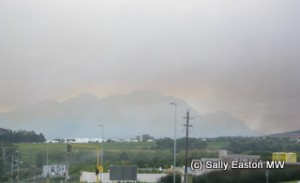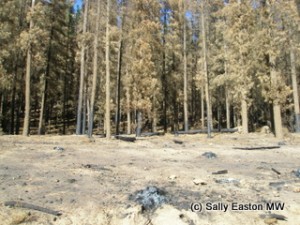Smoke tainted wine
Wild fires, bush fires, veld fires. It doesn’t matter where you are, fires have the ability to leave a nasty taste in wine. It’s not fire itself that’s at issue, but the smoke that hangs in vineyards, and which seems drawn to berry skins like moths to light. The options are to not pick the fruit, to treat it with high-tech kit, or blend it with other wine.
Guaiacol and 4-methylguaiacol are the main compounds involved. But they also occur commonly in wines aged with toasted oak, so are, to a certain extent, desired in some wine styles – toasted, smoky flavours are deliberately sought, especially in red wines.
The smoking of certain foods is big business where smoky flavours are actively sought. And the specific smoky flavours differ according to the fuel origin – beechwood imparts different flavours to oakwood. And where would the barbecue be without smoky flavours?

Bush fire smoke over Simonsberg in South Africa, 2009
In 2003 in Australia, thousands of tonnes of grapes were downgraded or rejected, amounting to an estimated AUD$7m. Research carried out in the heat of those burns provides the basis of our understanding of the issue.
What is smoke taint?
Smoke taint, though, suggests a presence of these compounds, and likely others too, that has not been deliberately sought by winemaking. They can be identified by an ‘excessively dry back palate character and a lingering retro-nasal ash character’ according to Australian Wine Research Institute (AWRI) research, and it is Australia where much research is being done.
Bush fires occurring near vineyards are known to cause contamination of the resulting wine. It first came to serious attention after the 2003 Australian vintage, where industry services dealt with a lot of grapes and wines tainted by smoke flavours. During January and February 2003 there had been a lot of bush fires in Victoria and southern New South Wales.
Smoke taint was observed in both grapes and wines.
Given the number of incidences, trials by the AWRI examined the issue during the vintage period, the main findings of which were:
- samples exhibited characters of smoky, burnt, ash, ashtray, salami, smoked salmon, etc.
- guaiacol and 4-methylguaiacol were the main compounds implicated in the taint. Both these compounds are regularly found in wines matured with toasted oak. An additional back-palate drying and ash note was found in contaminated samples.
- These compounds are thought not to be the only ones contributing to the taint. When control samples were spiked with guaiacol and 4-methylguaiacol, the sensory effect was less marked than in smoke-affected samples.
Possible ‘vineyard washing’ remedies were trialled to reduce guaiacol concentration in the grapes, but none of the options reduced the concentration in juice or crushed grapes.
Concentration of the compound increased with increasing time of maceration of juice with skins. This was consistent with anecdotal evidence of taint being worse in machine-harvested fruit and in pressings.
These compounds were found to reside in the skins of grapes.
Tests were done to see if was possible to reduce the taint during winemaking, for example, by using fining agents to ‘scalp’ the flavour compounds. Only activated carbon removed any guaiacol.
A sample of cabernet sauvignon grapes had been exposed to fire smoke for up to eight hours, 3-4 weeks before veraison. The concentration of guaiacol and 4-methyguaiacol fell only marginally in the subsequent to harvest, possibly as a result of dilution with berry growth.
The AWRI report said: “The results of these investigations provide conclusive evidence that tainting of grapes and wine by bushfire smoke can occur, and potentially have a major economic impact. Many affected white juices, wines and especially sparkling base wines, were deemed to be ‘unfit for purpose’ and were consequently severely downgraded in terms of value.”
Western Australia
In Western Australia, prescribed burns are an important part of landscape management. Drew Haswell, policy and science advisor at Western Australia’s (WA) department of environment and conservation said they carry out “prescribed burning in forests to stop the impact of damaging wild fires. We can only burn wet Karri forests in a small window of opportunity in April/May [when they are at their driest].” The Pemberton wine region is nearby these burns.
The department of environment and conservation has recently been working with the university and the wine industry association (WIAWA) to minimise the impact on the wine industry. In 2007, said Sue Vidovich, chief executive officer of WIAWA, they have “formed a Smoke Taint Working Group comprising representatives from WIAWA, the Department of Agriculture and Food and the Department of Environment and Conservation to learn more about the effect of smoke on vines and the resultant wines. We have one research project currently underway”.
Kristen Kennison, viticulture research and development officer at the Department of Agriculture and Food, Western Australia had been carrying out research for the previous 18 months. She said: “We need to know more about how smoke ends up in grapes, and what part of the grape smoke ends up in. Over 4000 compounds have been detected in smoke alone. A whole range of compounds could contribute to taint. Research is looking at the compounds within smoke taint. We’re using guaiacol and 4-methylguaiacol as indicators. We’re looking at particular growth stages of the vine, when during the season is smoke a particular problem. Also the timing and duration of smoke events. How vines assimilate and translocate the smoke compounds. We’ve applied smoke to vines for different durations, and we’re currently making wine from that fruit. Once we have knowledge, then can work on amelioration.”
Victoria
In Victoria in 2007, over 1m hectares were affected by bushfire, with King Valley and Alpine Valleys the worst affected. Having already lost a big chunk of the crop to frost and drought that year, extensive bush fires left smoke palls over vineyards. It was estimated the combined effect of the vintage’s natural conditions may cost the region AUD$70m.
Joanne Butterworth-Gray, chief executive, Victorian Wine Industry Association said: “We had six weeks of bush fires, starting on December 3rd, finishing in the third week of January ’07. About 50% of the state was covered in smoke haze for this time. Some companies in the north east are not using those grapes for their own brands. Some is left on the vines, some is blended out. What you can’t afford to have happen is the strength of ultra premium brands being affected”. Some producers have treated their wines with carbon.
Butterworth-Gray added: the Victorian government put forward a lot of funding for sustained research into the long term effects of smoke taint, and to assist businesses in getting over those effects. We don’t know if there is an accumulation effect in the vine itself, so part of the research will look at this.”
In 2009, there were again catastrophic bushfires in Victoria – the Yarra Valley – some started deliberately, which this time killed nearly 200 people. Tony Jordan, who heads up the Yarra Valley Winegrowers’ Association said after years of below average rainfall, and after “a four-day heatwave in south east Australia [at the end of January] flammable eucalypt forests were tinder dry. Strong, hot, northerly winds, with gusts over 100 kilometres per house created a recipe for bushfire disaster.”
About a quarter of the Yarra Valley vineyard was directly affected by grass and bush fires. Jordan added: “Many vines will be pruned back severely and they’ll recover. Vines were already shooting green growth, 8-10 weeks after the fires.”
It is now known that the effect in a single season is cumulative. Jordan said their “experience of smoke in 2007 and 2009 indicates that exposure to several days of moderate smoke levels is required to produce an effect above threshold.” The intensity and duration of exposure are also implicated, with even short periods resulting in a small amount of smoke compound pick up, though often below organoleptic thresholds.

Aftermath of bushfires, Cederberg, South Africa, 2009
Treatment
A sporadic and individual problem it may be, but the commercial decisions can be harsh, especially without contaminant insurance. Some sort of treatment exists (see Memstar below). David Wollan, director of Wine Network said: “A number of wine producers have said they’re not prepared to take the risk and they rejected a lot of grapes.” But others, especially a larger producer who has more than one tier of brands, an option is to treat the wine and put it into a lower tier of wine brand.
Detection thresholds vary by style of wine, with fruit for sparkling base wine having the lowest threshold. One industry insider said: “a smoky, bacon flavour in a sparkling base might see a significant downgrade for example from AUD$3/litre to AUD$0.30/litre.” The threshold for reds is obviously more forgiving, but varies by grape variety. Blending away is one option, for larger wineries, but a guaiacol concentration above a certain level is likely to see the fruit left on the vine without commercial value. It’s clear that smoke taint is unpleasant. But the overall impact to the industry is not great.
Memstar – a treatment option (MEMbrane Separation, Treatment And Recombination)
This a group of reverse osmosis membrane processes. Wine is pumped under high pressure. Compounds of low molecular weight pass through a highly selective membrane. The liquid passing through the membrane is treated to remove some of the unwanted compounds, and the treated portion is returned – ‘recombined’ to the wine.
For smoke taint a ‘loose’ membrane is required. Guaiacol and 4-methylguaiacol have a higher molecular weight than, for example, ethanol and acetic acid. Compounds are removed by passing the liquid through activated carbon filters, though this also removes some other wine components that passed through the filter with guaiacol. The treated portion is added back to the wine.
Depending on the level of taint, it costs about USD$0.30/litre to use the technology.
David Wollan, director of Wine Network, which runs the Memstar technology, said: “We can reduce the taint components. We can’t eliminate the smoke taint, but we can take out a portion of what’s there each time the wine passes. We estimate 8-10% of taint is removed each time. Wine is processed until it’s at an acceptable level, which could be 3 to 10 times going round the loop.”
Smoke taint – not brettanomyces.
Smoke taint is not to be confused with brettanomyces, which is a taint cause by yeast. Wines made from smoke tainted fruit show an acrid, burnt, ‘morning after’ ashtray note. Wines tainted by brettanomyces display horsey, medicinal, farmyard, ‘elastoplast’ notes.
The compounds responsible for these two taints are different, but they do all come from a group of volatile phenols
- Smoke taint culprits are guaiacol and 4-methylguaiacol.
- Brettanomyces culprits are 4-ethylphenol and 4-ethylguaiacol.
With brettanomyces, many argue a little influence offers complexity to wine. With smoke, any detectable amount will be regarded as a fault in an aromatic white wine, but in a robust wine aged in new oak, the story is more complicated. A proportion of the two main compounds measured to identify taint, are often regarded as positive complexing influences, so the line between flavour enhancement and flavour fault in robust reds, as with brettanomyces, is a fine one. More research needs to be done on the other compounds that contribute to smoke taint.



